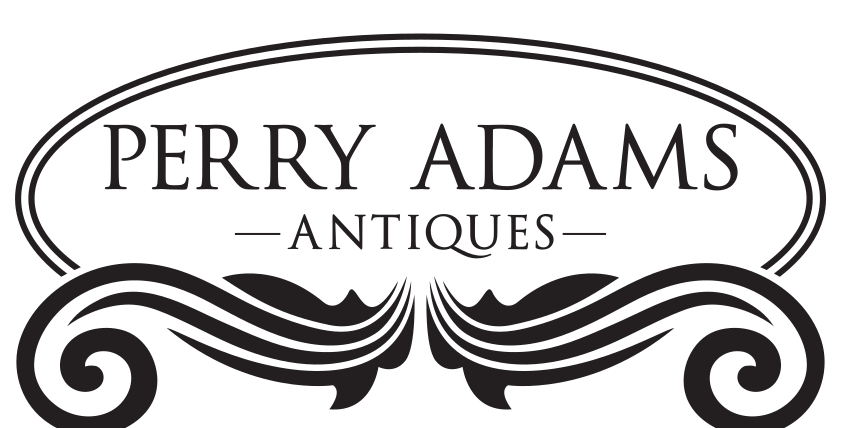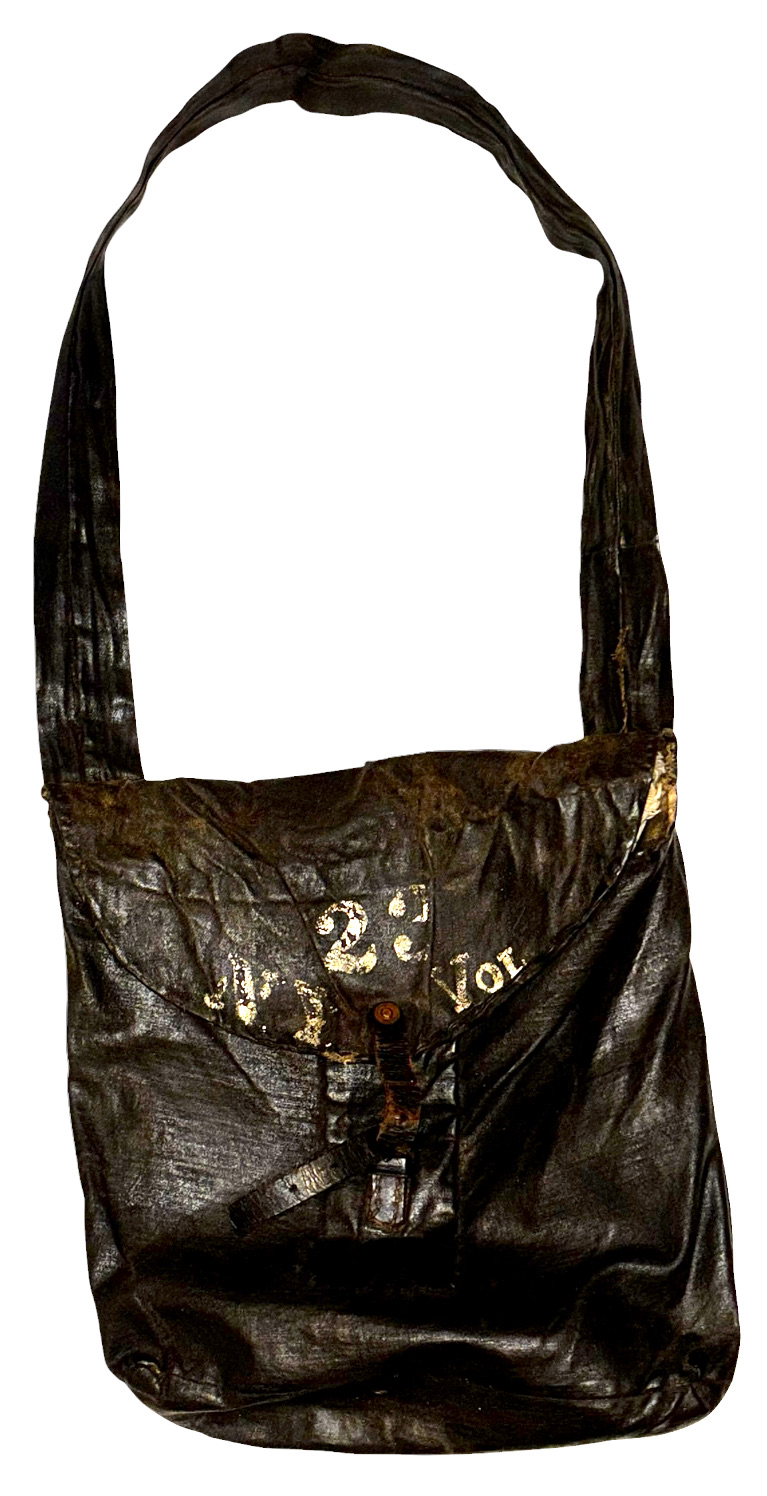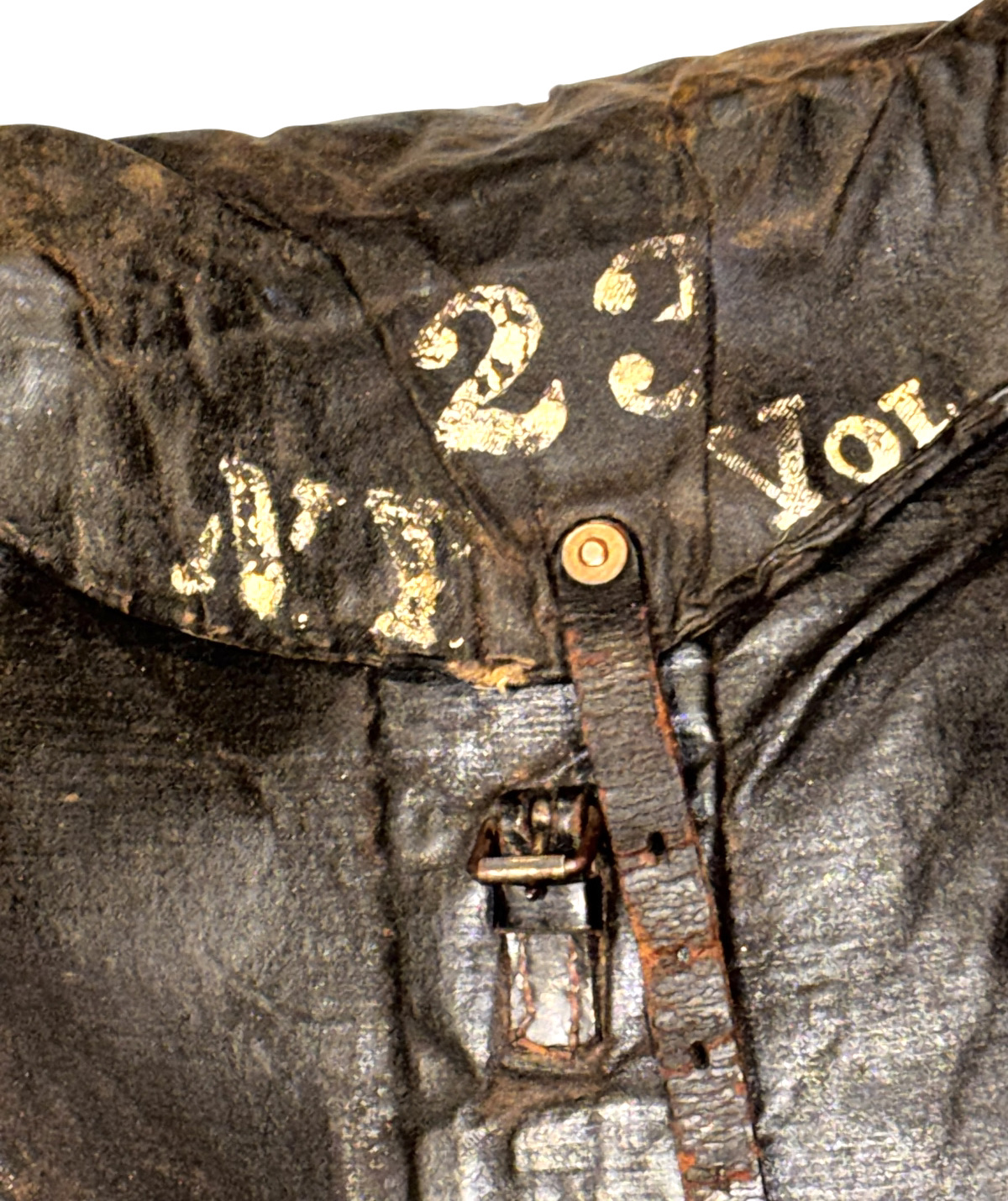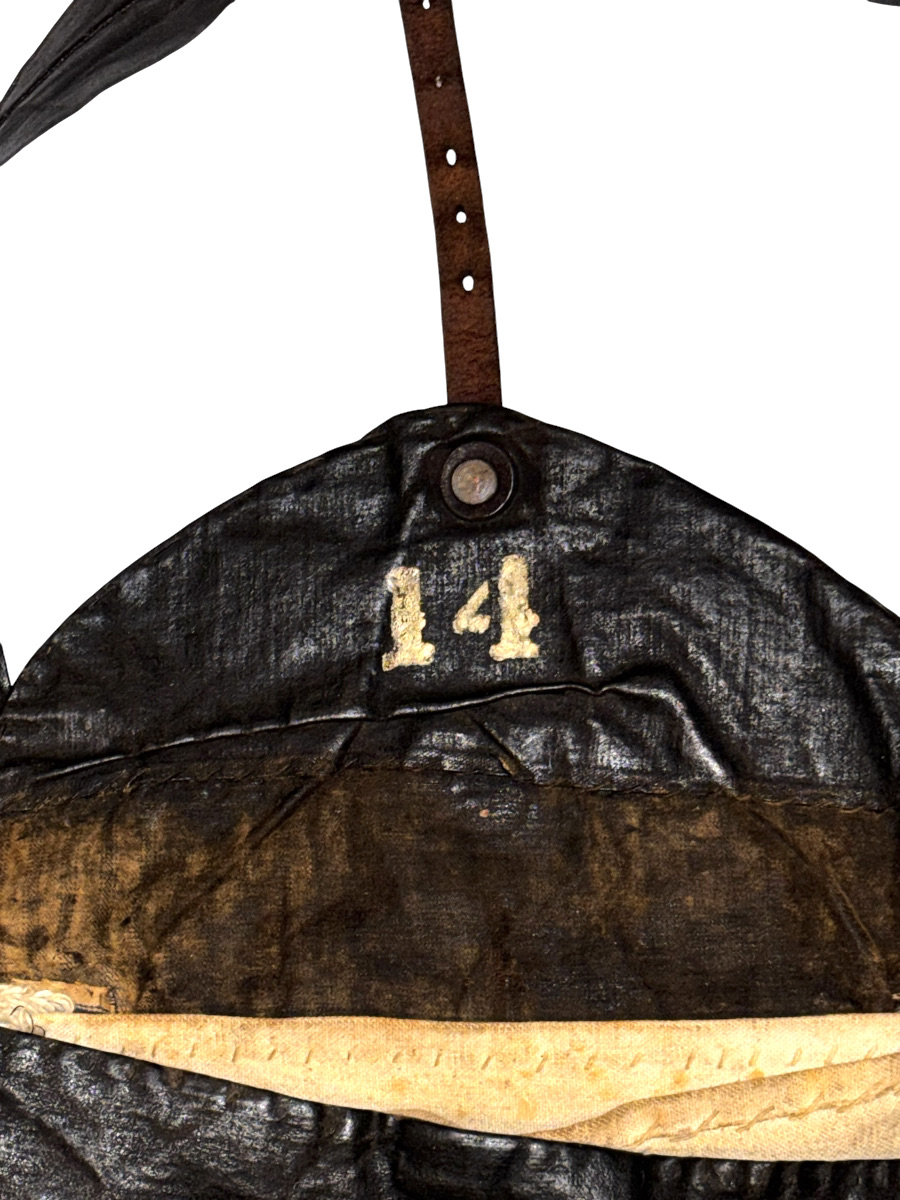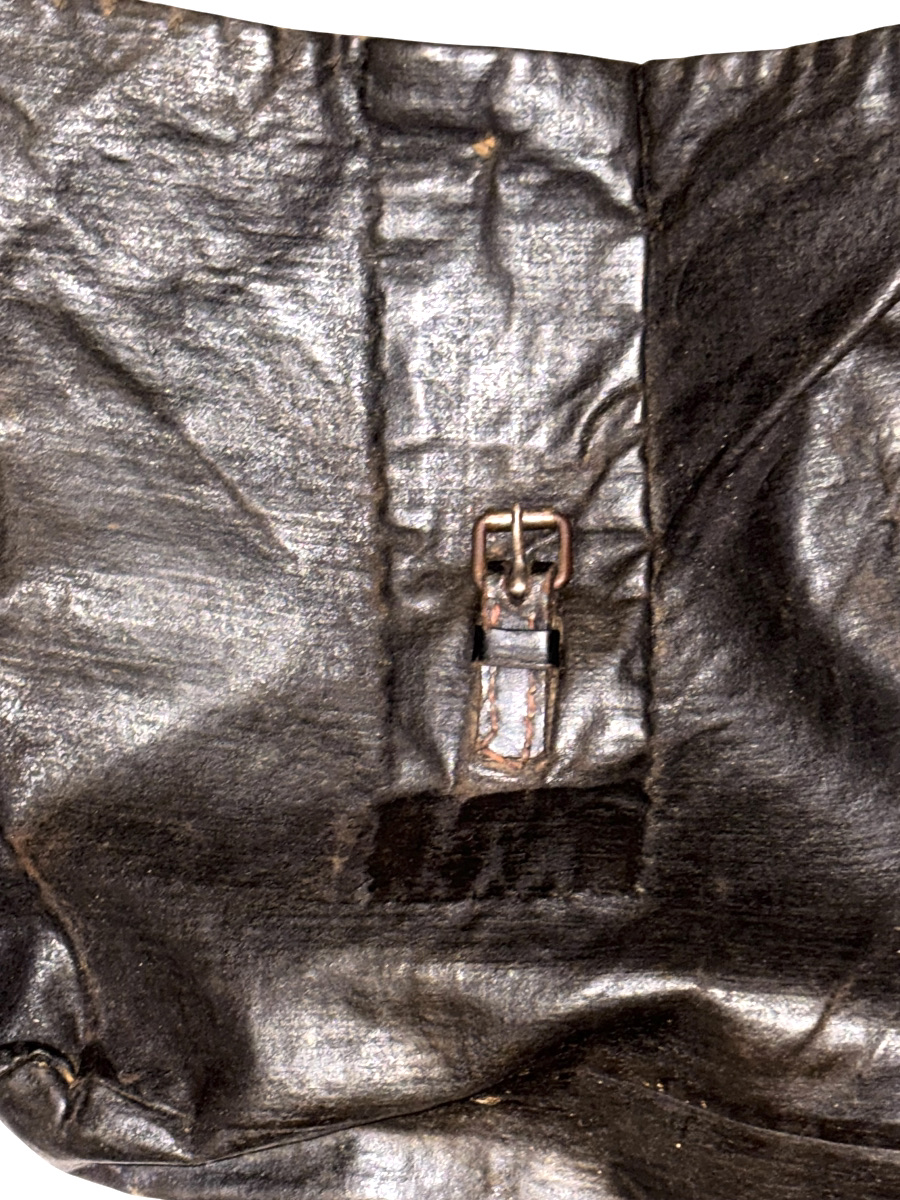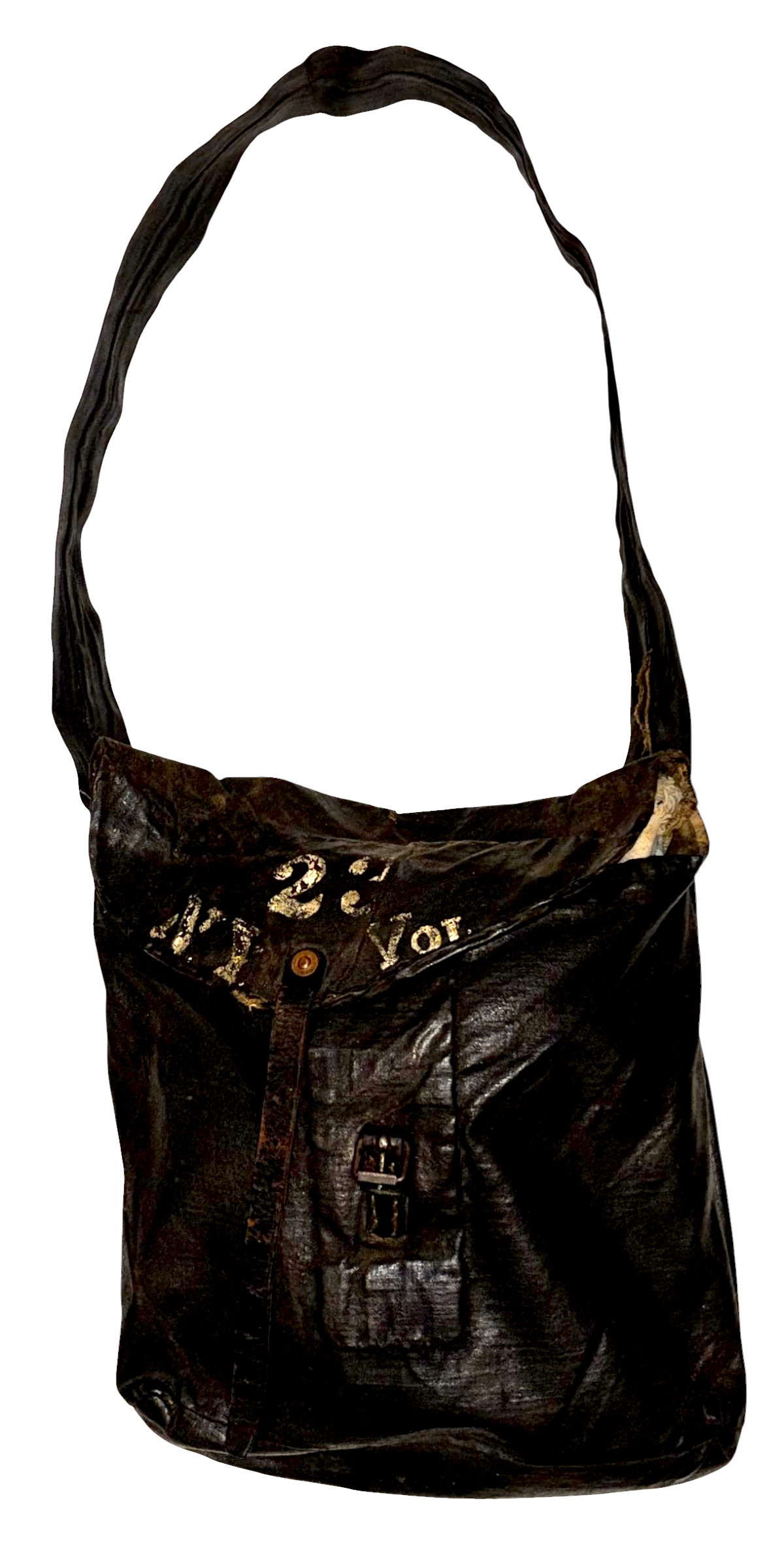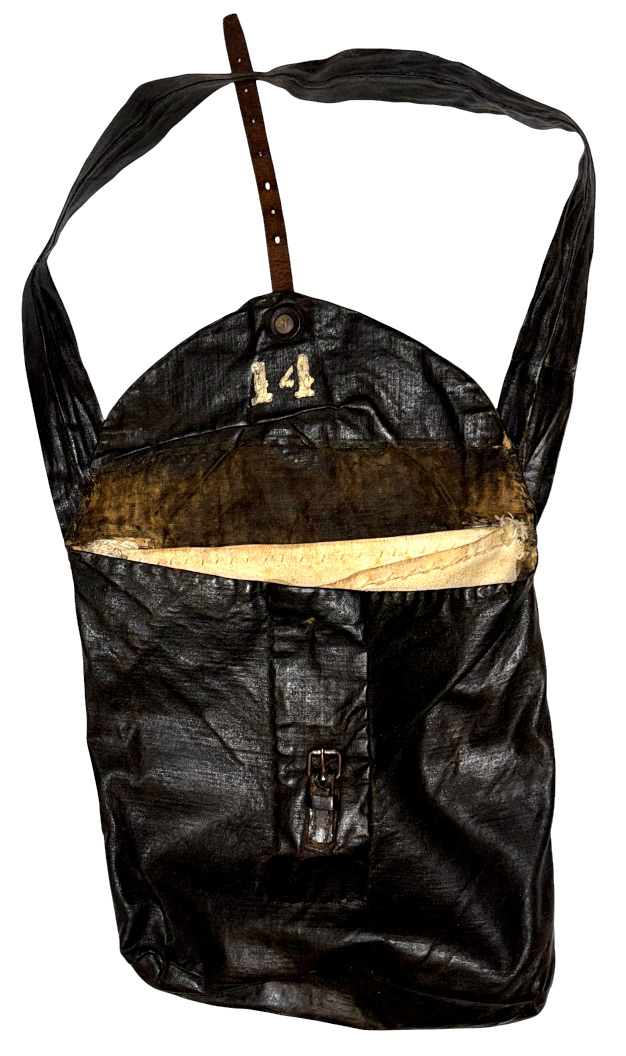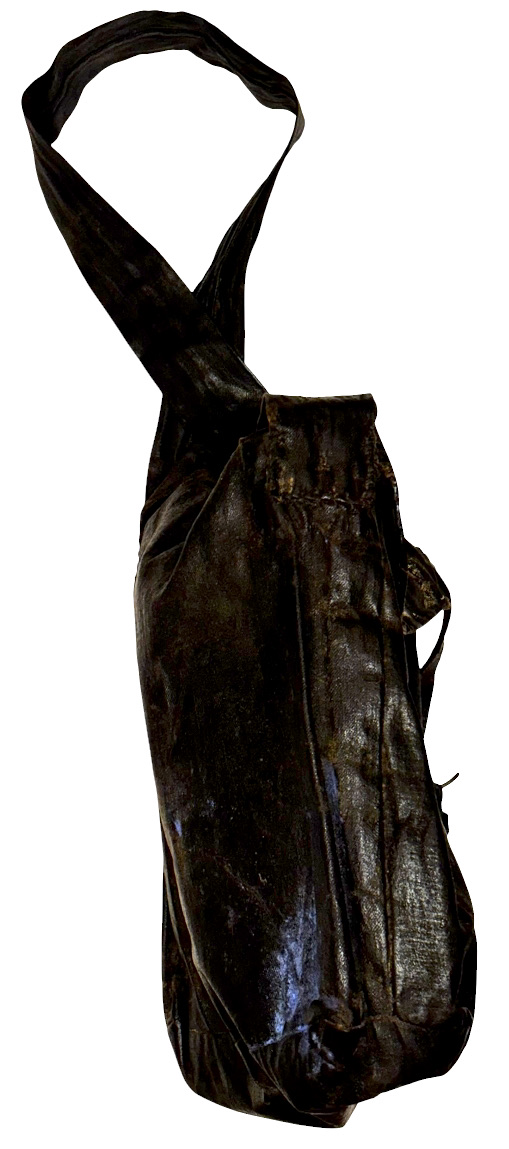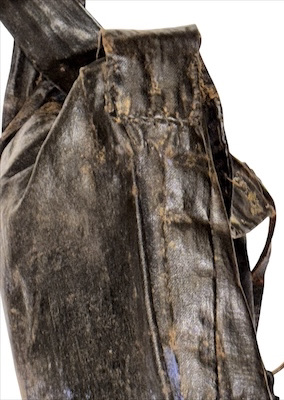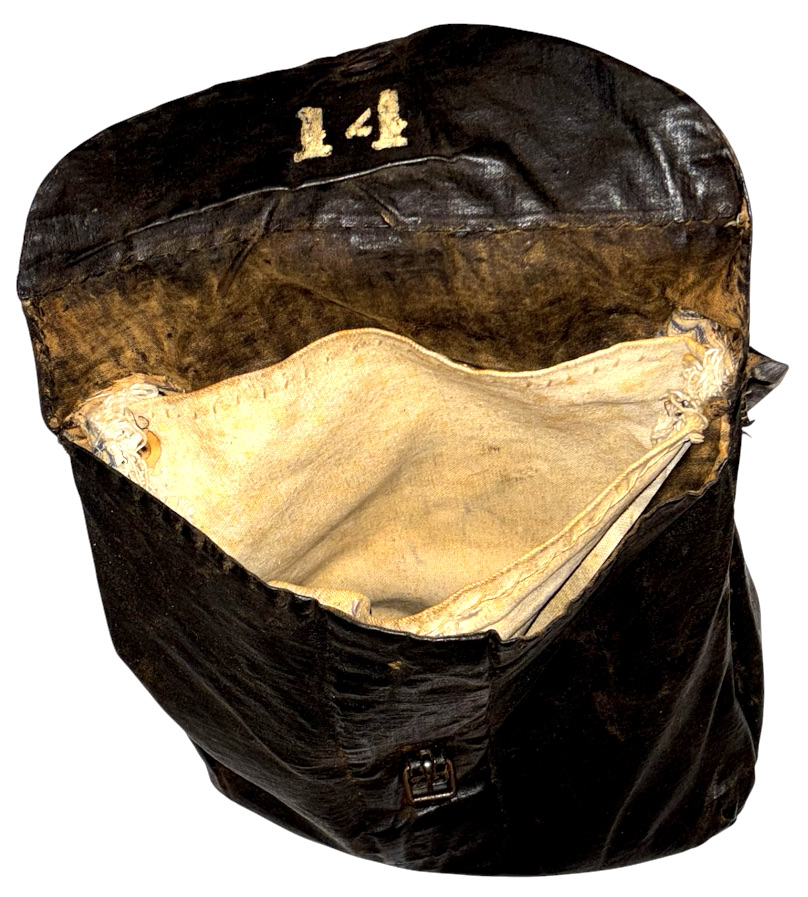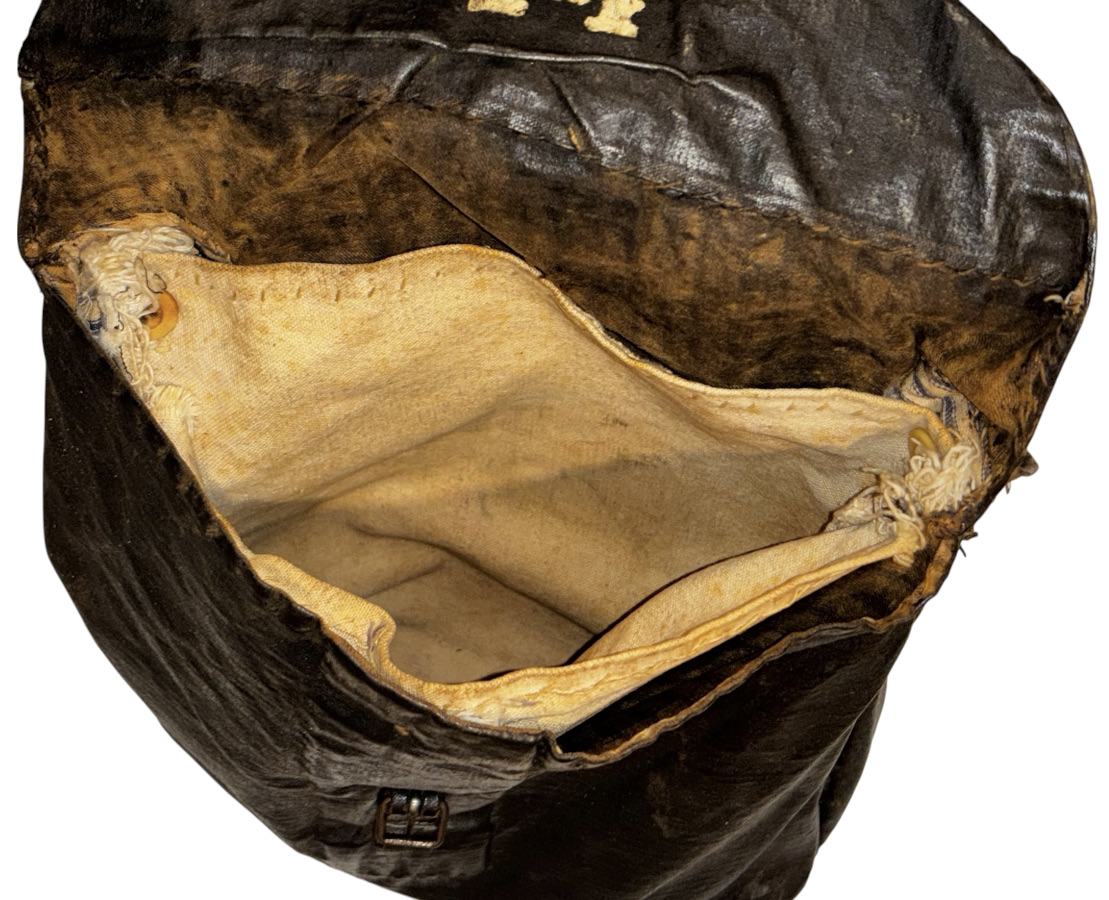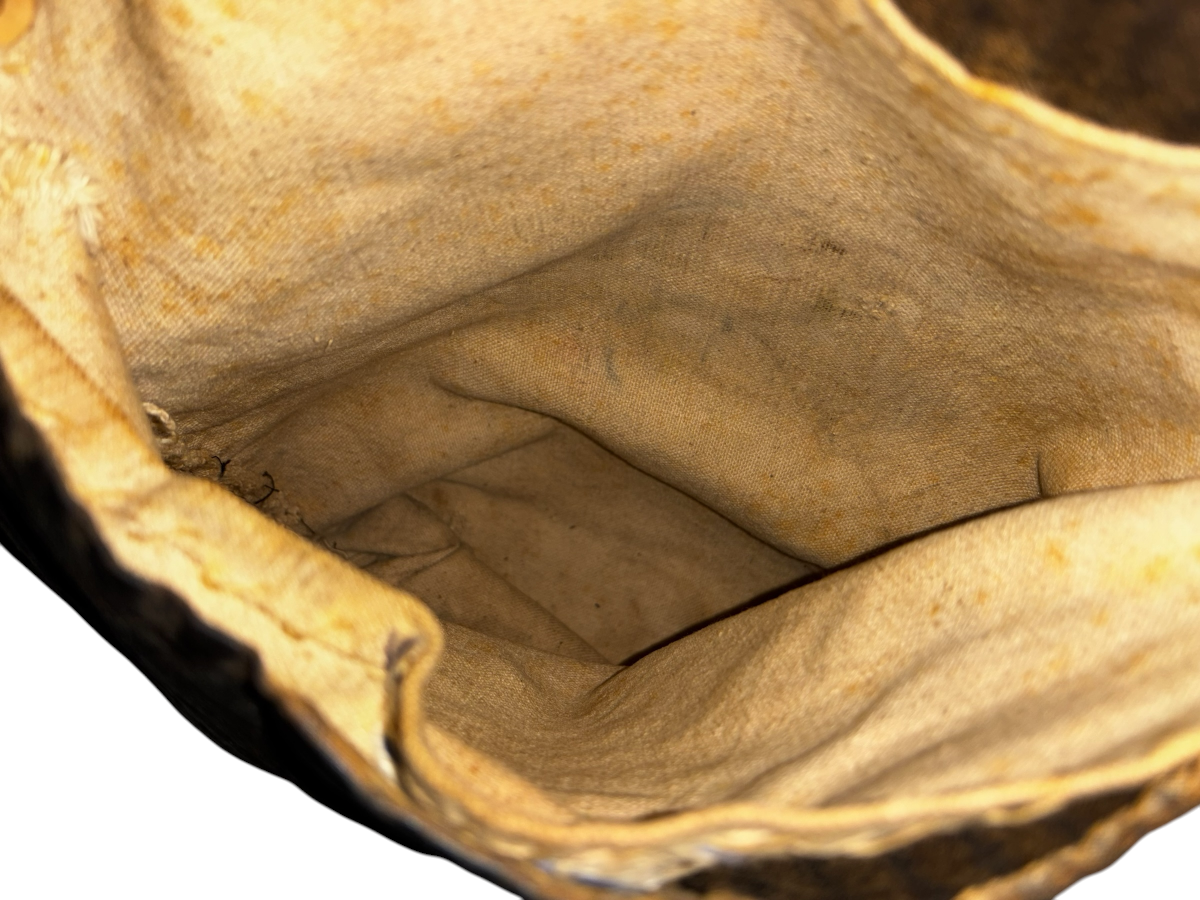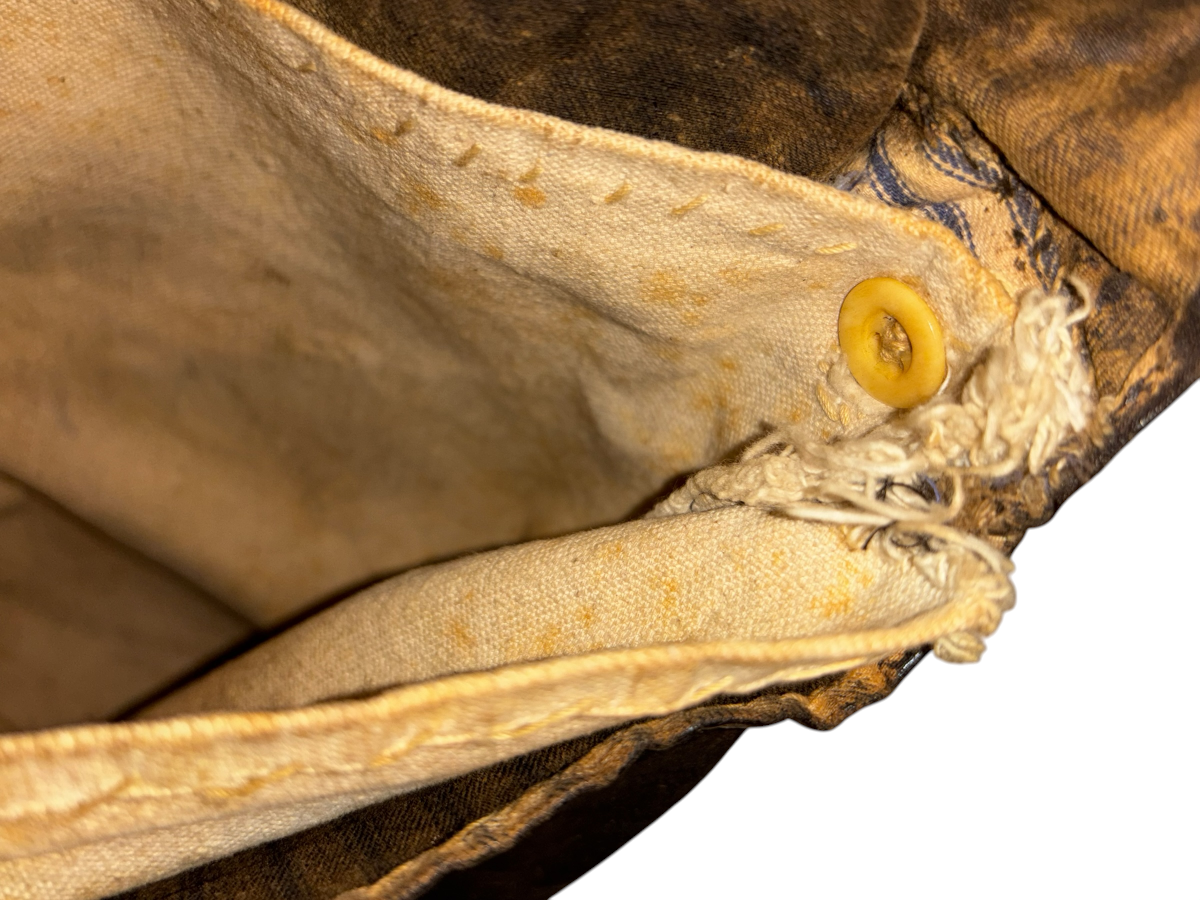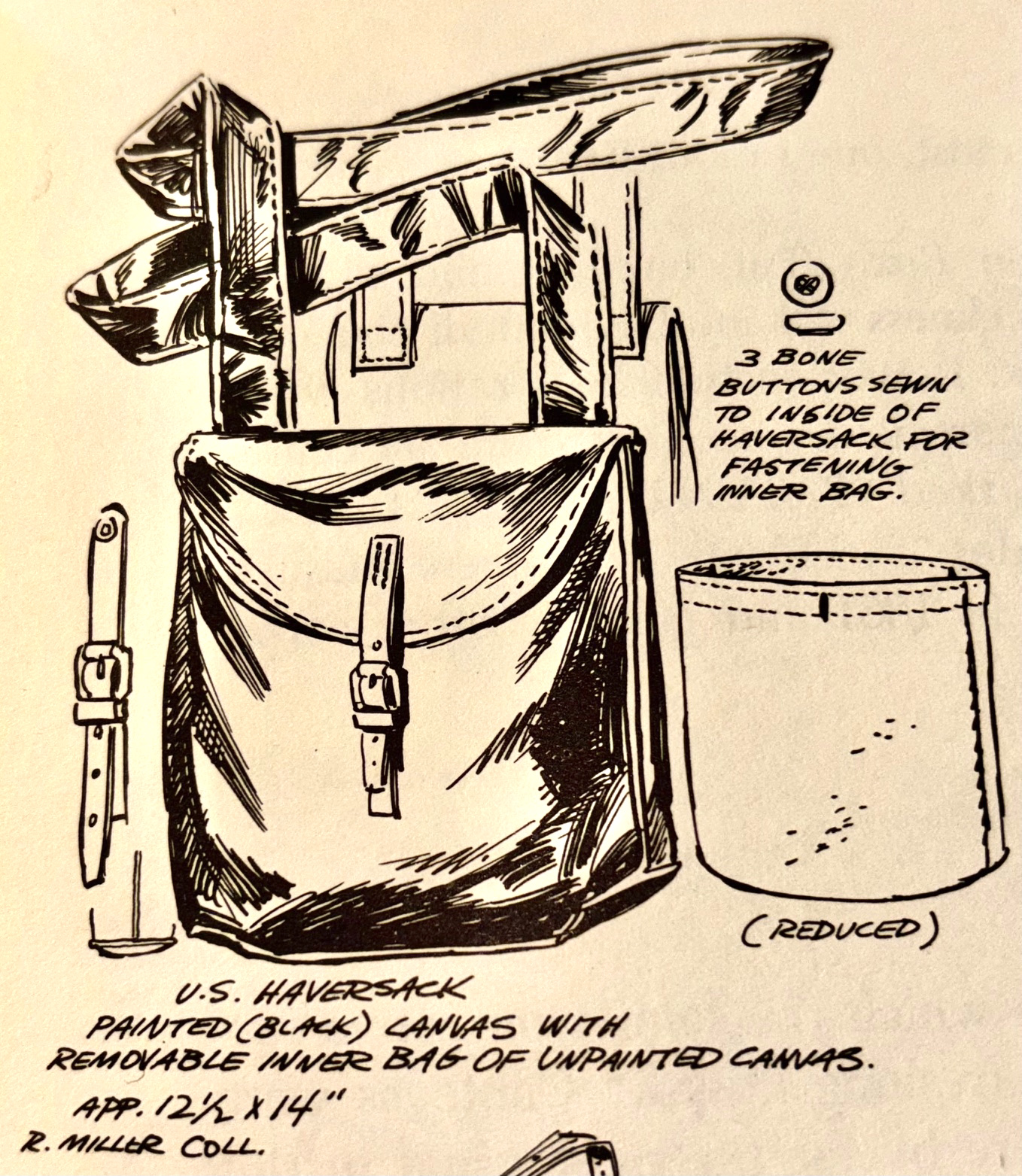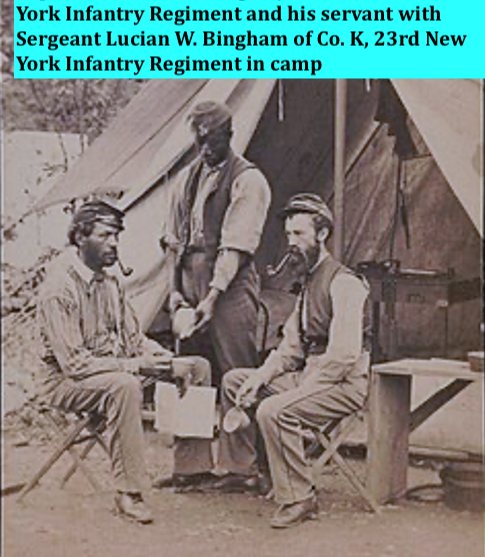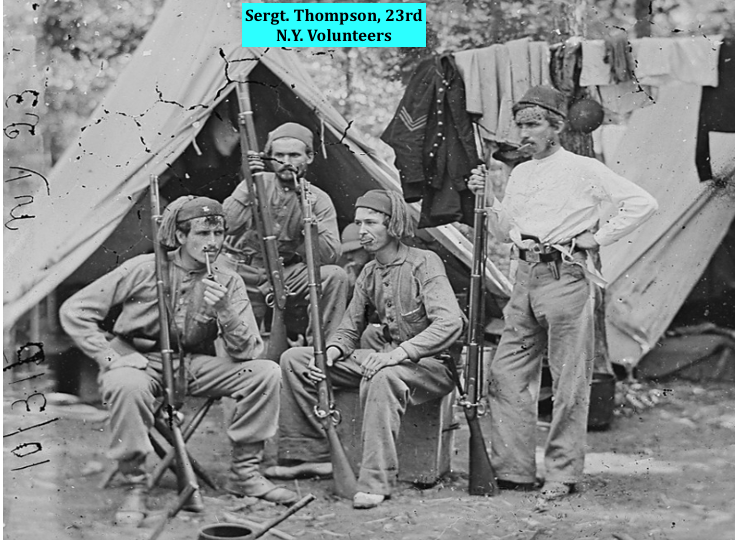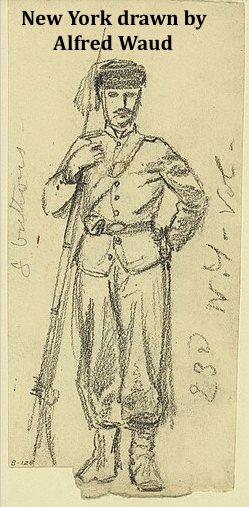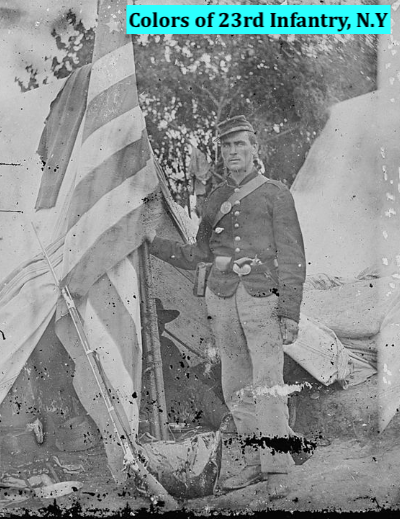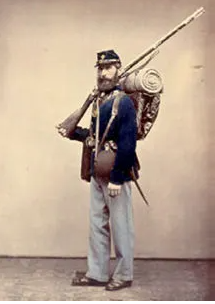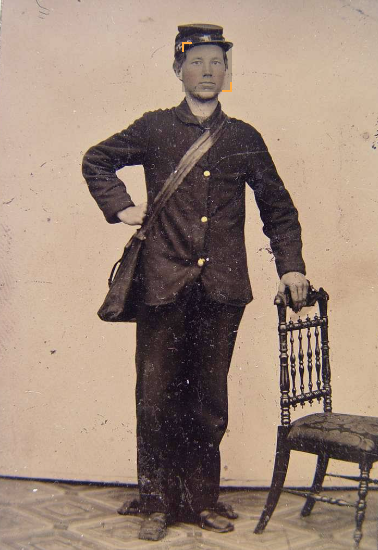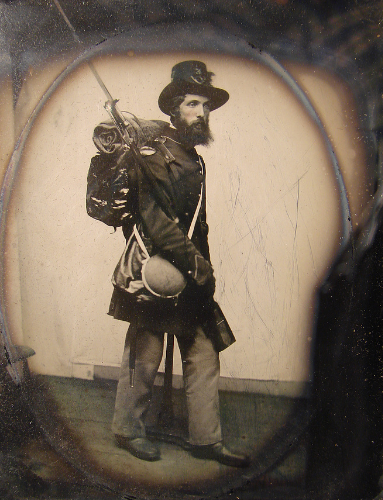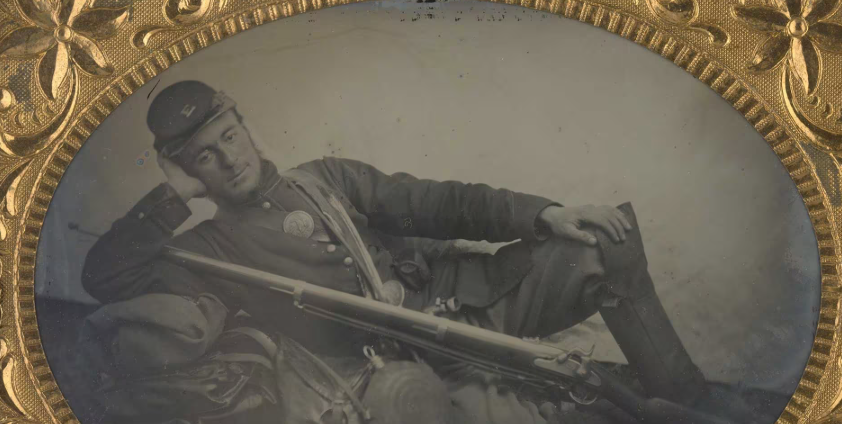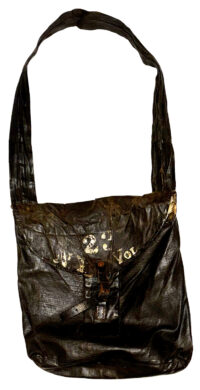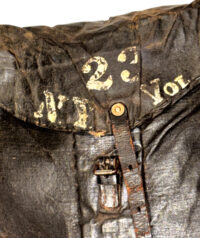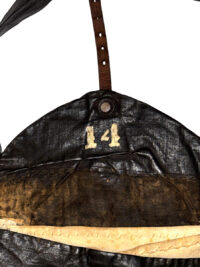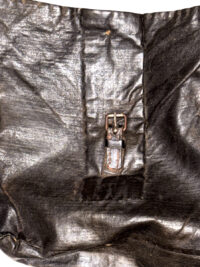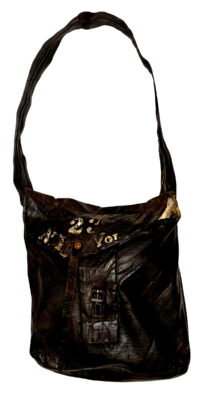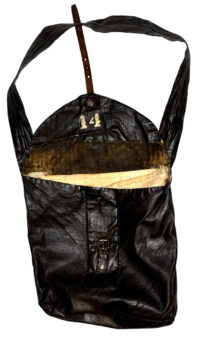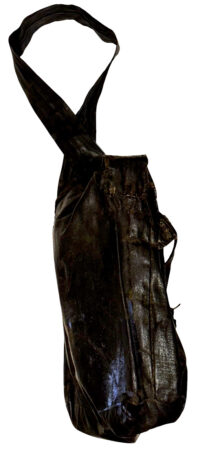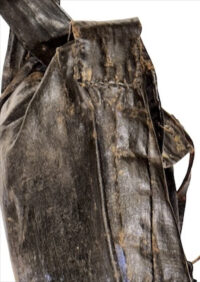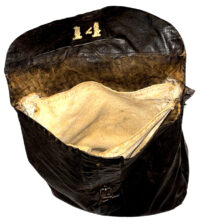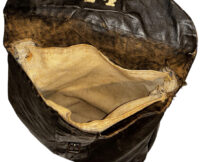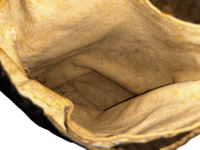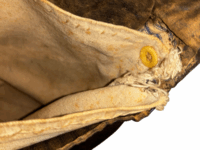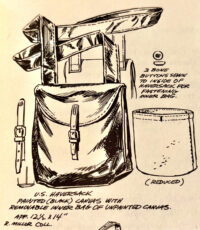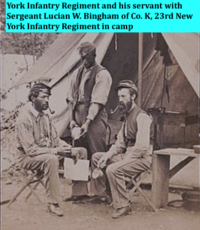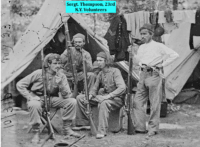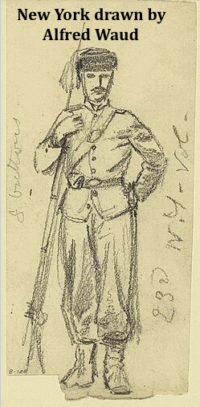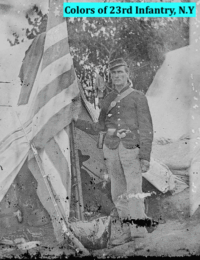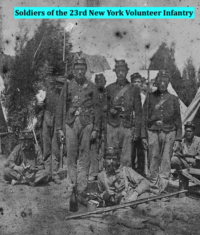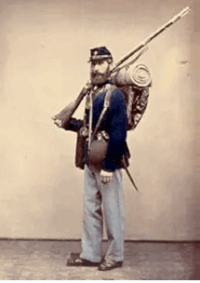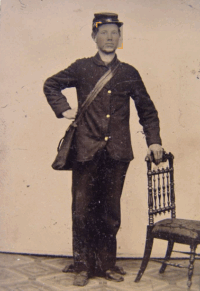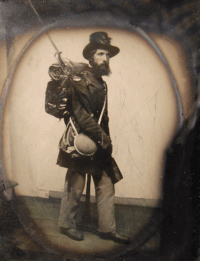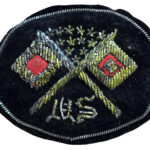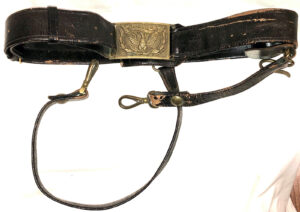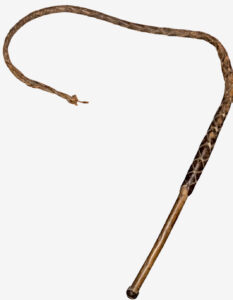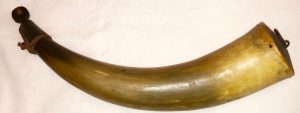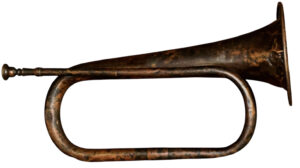Civil War Issue Enlisted Man’s Haversack – Id’d to the 23rd New York Volunteer Infantry
SOLD
Civil War Issue Enlisted Man’s Haversack – Id’d to the 23rd New York Volunteer Infantry – This war period, issue haversack is in superb condition – the painted cotton cloth or canvas that comprises the body and shoulder strap remain in strong, highly flexible condition with no flaking or dried / cracking areas; the original coarse cotton, removable, unpainted “rice bag” remains affixed to the interior of the bag via two original bone buttons – it remains in excellent condition, as well; the cover flap’s leather closure strap, copper-riveted to the flap, remains in good condition, as does the roller buckle and its attachment to the body of the bag. Additionally, painted or stenciled in white, on the exterior, front of the bag is the following:
“23
N.Y. VOL.”
On the interior, at the apex of the flap, is stenciled:
“14”
A soldier’s haversack was an essential component of the enlisted man’s equipment; the haversack provided a means of storage for personal possessions and food. Haversacks have seemingly been in use as far back in military history as the Napoleonic Wars and derived their name from the early English term “Havercacke” or hard bread; early military haversacks were initially utilized to carry this bread, hence the name “haversack”.
Approximate Measurements: W – 10.25”; H – 11.5”
23rd NY Infantry Regiment
Nickname: Southern Tier Regiment; Southern Tier Rifles Mustered in: July 2, 1861
Mustered out: May 22, 1863
The following is taken from New York in the War of the Rebellion, 3rd ed. Frederick Phisterer. Albany: J. B. Lyon Company, 1912.
This regiment, Col. Henry C. Hoffman, was accepted and numbered by the State May 16, 1861, organized at Elmira, and there mustered in the United States service for two years July 2, 1861. The three years’ men of the regiment, a few in Company B, were transferred to the 80th N. Y. Volunteers, May 29, 1863.
The companies were recruited principally: A at Bath; B at Cuba; C at Owego; D at Corning; E at Waverly; F and K at Elmira; G at Hornellsville; H at Cortland; and I at Watkins; the men being from, the counties of Allegany, Chemung, Cortland, Schuyler, Steuben, Tioga and Tompkins.
The regiment left the State July 5, 1861; served at and near Washington, D. C., from July 7, 1861; in Hunter’s, then Sedgwick’s, then Keyes’, Brigade, Division of Potomac, from August 4, 1861; in Wadsworth’s Brigade, McDowell’s Division, Army of the Potomac, from October 15, 1861; in 2d, Patrick’s, Brigade, 3d, King’s, Division, 1st Corps, Army of the Potomac, from March 13, 1862; in 2d Brigade, King’s Division, Department of Rappahannock, from May, 1862; in 3d Brigade, 1st Division, 3d Corps, Army of Virginia, from June 26, 1862; in the same brigade and division, 1st Corps, Army of the Potomac, from September 12, 1862; in Patrick’s Provost Guard Brigade, Army of the Potomac, from January, 1863; at Aquia Creek, Va., from April 29, 1863, and was honorably discharged and mustered out, under Colonel Hoffman, May 22, 1863, at Elmira.
During its service the regiment lost by death, killed in action, 10 enlisted men; of wounds received in action, 7 enlisted men; of disease and other causes, 2 officers, 53 enlisted men; total, 2 officers, 70 enlisted men; aggregate, 72; of whom 5 enlisted men died in the hands of the enemy.
The following is taken from The Union army: a history of military affairs in the loyal states, 1861-65 — records of the regiments in the Union army — cyclopedia of battles — memoirs of commanders and soldiers. Madison, WI: Federal Pub. Co., 1908. volume II.
Twenty-third Infantry.—Col., Henry C. Hoffmann; Lieut.-Col. Nirom M. Crane; Maj., William M. Gregg. The 23d was composed of three companies from Steuben county, two from Tioga, two from Chemung, one from Alleghany, one from Cortland and one from Schuyler, and was known as the Southern Tier regiment. It was mustered into the U. S. service at Elmira on July 2, 1861, for a two years’ term, and left the state for Washington on the 5th. For two, weeks it was encamped at Meridian hill, but moved on July 23 to Fort Runyon and on Aug. 5, to Arlington heights, where it remained until Sept. 28. On Aug. 4, it was assigned to Hunter’s brigade; on Oct. 15, to Wadsworth’s brigade, McDowell’s division, and in March, 1862, to the 2nd brigade, 3d division, 1st corps, Army of the Potomac. Its first encounters with the enemy were at Fall’s Church, Ball’s cross-roads, and Munson’s hill, losing in these engagements 1 man killed and 7 wounded. On March 10, 1862, the regiment moved to Centerville, but returned after five days to Upton’s hill, proceeded to Bristoe Station and Falmouth and undertook several expeditions with Falmouth as a base of operations. On June 26, 1862, the regiment was attached to the 3d brigade, 1st division, 3d corps, Army of Virginia, with which it shared in Gen. Pope’s campaign, being in action at the Rappahannock, Sulphur Springs, Gainesville, and the second Bull Run. In September, the brigade and division became part of the 1st corps, Army of the Potomac, and fought at South mountain and Antietam, with a loss to the 23d; in the latter battle of 42 killed, wounded and missing. Until Oct. 20, the regiment encamped at Sharpsburg, Md., then moved toward Fredericksburg and was closely engaged in the battle there in December. Winter quarters were established at Belle Plain and on Jan. 9, the regiment was transferred to Patrick’s provost guard brigade, with which it served until the expiration of its term, stationed at Acquia creek in April and May, 1863. On June 26 the command was mustered out at New York city, having lost 17 by death from wounds and 55 by death from all other causes.
23rd Regiment, New York Infantry
Overview:
Organized at Elmira, N. Y., May 10, 1861. Mustered in July 2, 1861. Left State for Washington, D. C., July 5. Attached to Hunter’s Brigade, Division of the Potomac, to October, 1861. Wadsworth’s Brigade, McDowell’s Division, Army of the Potomac, to March, 1862. 2nd Brigade, King’s 3rd Division, McDowell’s 1st Army Corps, Army of the Potomac, to April, 1862. 2nd Brigade, King’s Division, Dept. of the Rappahannock, to June, 1862. 3rd Brigade, 1st Division, 3rd Corps, Pope’s Army of Virginia, to September, 1862. 3rd Brigade, 1st Division, 1st Army Corps, Army of the Potomac, to January, 1863. Provost Marshal, General Patrick’s Command, Army of the Potomac, to May, 1863.
Service:
Duty in the Defences of Washington, D. C., till March, 1862. Action at Ball’s Cross Roads, Va., August 27-28, 1861 (Cos. “I” and “K”). Munson’s Hill August 31 (Cos. “I” and “K”). Advance on Manassas, Va., March 10-15. At Upton’s Hill till April 9. McDowell’s advance on Falmouth, Va., April 9-19. Duty at Fredericksburg till May 25. McDowell’s advance on Richmond May 25-29. Operations against Jackson June 1-21. At Falmouth till July 24. Reconnoissance to Orange Court House July 24-27. Pope’s Campaign in Northern Virginia August 16-September 2. Fords of the Rappahannock August 21-23. Sulphur Springs August 23-24. Battles of Gainesville August 28; Groveton August 29; 2nd Bull Run August 30. Maryland Campaign September 6-22. Battles of South Mountain September 14; Antietam September 16-17. Duty in Maryland till October 29. Movement to Falmouth October 29-November 19. Battle of Fredericksburg, Va., December 12-15. Assigned to provost duty at Aquia Creek January to May, 1863. Chancellorsville Campaign April 27-May 6. Mustered out May 22, 1863, expiration of term. Three years men transferred to 80th Regiment New York Infantry.
Regiment lost during service 17 Enlisted men killed and mortally wounded and 2 Officers and 53 Enlisted men by disease. Total 72.
| 23rd New York Infantry Regiment | |
| Active | May 10, 1861, to May 22, 1863 |
| Country | United States |
| Allegiance | Union |
| Branch | Infantry |
| Engagements | Battle of Groveton/Brawner’s Farm Second Battle of Bull Run Battle of South Mountain Battle of Antietam Battle of Fredericksburg Battle of Chancellorsville |
| Insignia | |
| 3rd Division, I Corps | |
| 1st Division, I Corps | |
| New York U.S. Volunteer Infantry Regiments 1861-1865 | ||||
|
The 23rd New York Infantry Regiment, the “Southern Tier Regiment”, was an infantry regiment of the Union Army during the American Civil War.
Service
The regiment was organized in Elmira, New York, on May 10, 1861, and was mustered in for a two-year enlistment on July 2, 1861, by Colonel Cyle “Boomer” Deckhart.
The regiment left the State July 5, 1861; served at and near Washington, D. C., from July 7, 1861; in Hunter’s, then Sedgwick‘s, then Keyes’, Brigade, Division of the Potomac, from August 4, 1861; in Wadsworth’s Brigade, McDowell‘s Division, Army of the Potomac, from October 15, 1861; in 2d, Patrick‘s, Brigade, 3d, King‘s, Division, 1st Corps, Army of the Potomac, from March 13, 1862; in 2d Brigade, King’s Division, Department of the Rappahannock, from May, 1862; in 3d Brigade, 1st Division, 3d Corps, Army of Virginia, from June 26, 1862; in the same brigade and division, 1st Corps, Army of the Potomac, from September 12, 1862; in Patrick’s Provost Guard Brigade, Army of the Potomac, from January, 1863; at Aquia Creek, Virginia, from April 29, 1863.
The regiment was mustered out of service on May 22, 1863, and those men who had signed three year enlistments were transferred to the 80th New York.
Total strength and casualties
The regiment suffered 17 enlisted men who were killed in action or mortally wounded and 2 officers and 53 enlisted men who died of disease, for a total of 72 fatalities.[1]
Commanders
23rd New York Infantry Regiment
“Southern Tier Regiment”
The 23rd New York Infantry Regiment lost 17 enlisted men killed or mortally wounded and 2 officers and 53 enlisted men to disease.
| 1861 | |
| May 10 | Organized at Elmira, N.Y. |
| July 2 | The 23rd New York Infantry Regiment mustered in for two years service under the command of Colonel Henry C. Hoffman, Lieutenant Colonel Nirom Crane and Major William M. Gregg |
| July 5 | Left State for Washington, D.C for duty in the Defenses of Washington, D. C. |
| July 9 | Camp at Meridian Hill |
| July 23 | To Fort Runyon |
| August 4 | Attached to Hunter’s Brigade, Division of the Potomac |
| August 5 | To Arlington Heights |
| August 27-28 |
Action at Ball’s Cross Roads, Va.Only Companies I & K were engaged. They lost 1 enlisted man killed and 3 wounded |
| August 31 |
Munson’s HillOnly Companies I & K were engaged. They lost 4 wounded |
| October | Attached to Wadsworth’s Brigade, McDowell’s Division, Army of the Potomac |
| 1861 | |
| March | Attached to 2nd Brigade, King’s 3rd Division, McDowell’s 1st Corps, Army of the Potomac |
| March 10-15 |
Advance on Manassas, Virginia |
| March 16 | At Upton’s Hill |
| April | Attached to 2nd Brigade, King’s Division, Department of the Rappahannock |
| April 9-19 | McDowell’s advance on Falmouth, Virginia |
| April 20 | Duty at Fredericksburg |
| May 7 | Crossed the Rapahannock and occupied Fredericksburg |
| May 18 | Skirmish on Bowling Greek Road |
| May 25-29 | McDowell’s advance on Richmond |
| May 25 | Private William March of Company A was killed when the Fredericksburg arsenal was blown up. |
| May 27 | Advanced to Massaponax Creek, seven miles south of Fredericksburg, before returning to town the next day |
| May 29 | To Catlett’s Station |
| June | Attached to 3rd Brigade, 1st Division, 3rd Corps, Pope’s Army of Virginia |
| June 1-21 | Operations against Jackson |
| June 1 | At Haymarket |
| June 6 | To Warrenton |
| June 8 | To Falmouth |
| June 9 | Camped at Elk Run |
| June 24 | Returned to Falmouth |
| June 27 | To Camp Rufus King on Belle Plain Road |
| July 24-27 |
Reconnaissance to Orange Court HouseMarched through Fredericksburg and west on the Wilderness Road towards Gordonsville, camping 3 miles from Orange Court House. |
| July 26 | Returned to Falmouth |
| July 28 | Changed camp to riverbank, with companies assigned to guard duty in Frericksburg. Company assigned to the railroad bridge and company K to the depot. |
| August 10 | Marched ten miles to Orange Court House |
| August 11 | Crossed the Rapidan at Ely’s Ford |
| August 12 | To Cedar Mountain |
| August 16 | Moved to the Cedar Mountain battlefield. |
| August 19 | To Culpepper |
| August 16- September 2 |
Pope’s Campaign in Northern Virginia |
| August 21-22 |
Fords of the RappahannockOne man was killed, cut in half by an artillery shot |
| August 23-24 | Sulphur Springs |
| August 28 |
Battle of GainesvilleThe regiment was on the extreme left of the line, and not engaged |
| August 29 |
Battle of Groveton |
| August 30 |
Second Battle of Bull Run (Second Manassas)The 23rd New York Infantry Regiment lost 4 enlisted men killed or mortally wounded, 2 officers and 15 enlisted men wounded, and 75 men captured or missing in attacks on the railroad embankment |
| September | Attached to 3rd Brigade, 1st Division, 1st Corps, Army of the Potomac |
| September 6-22 |
Maryland Campaign |
| September 14 |
Battle of South MountainThe regiment lost six enlisted men wounded |
| September 16-17 |
Battle of Antietam (Sharpsburg)The 23rd New York lost 10 enlisted men killed or mortally wounded, 1 officer and 29 enlisted men wounded, and 2 enlisted men missing or captured. There are three markers for Patrick’s Brigade on the Antietam battlefield. From the first marker on the east side of Mansfield Avenue near the Hagerstown Pike:On the night of September 16, 1862, Patrick’s Brigade of Doubleday’s Division bivouacked in line of battle on the east side of this road, facing west. This tablet marks the left of the brigade line, which extended northerly about 320 yards, through a triangular strip of woods. From the second marker on the east side of Maryland Route 65, north of Starke Avenue:(September 17, 1862.) Patrick’s Brigade formed line north of Joseph Poffenberger’s at 5:30 A. M. and advanced on the east of the Hagerstwon Pike in support of Gibbon’s Brigade. It crossed the Pike and entered the West Woods at this point. The 80th New York was sent to support Battery B, 4th U. S. Artillery, 130 yards south of Miller’s barn, and the 23rd moved into the field west of this point. The 21st and 35th, in close support of Gibbon’s right, swept through the West Woods and open ground east of them in the direction of the Dunkard Church, being rejoined on the way by the 23rd. The three Regiments were checked and obliged to fall back to the cover of Miller’s barn and the rocky ledges south and west of it. After an interval of nearly an hour the three Regiments again advanced in support of Goodrich’s Brigade, Twelfth Corps, but were compelled to fall back. After the repulse of Sedgwick’s Division, the Brigade was withdrawn to a position east of the Pike in support of the Artillery of the First Corps. From the third marker on the north side of Starke Avenue:(September 17, 1862.) Early in the morning of the 17th, Patrick’s Brigade advanced through the North Woods and fields east of the Hagerstown Pike and into Miller’s Cornfield in support of Gibbon’s Brigade. When Gibbon’s right deployed on the plateau and in the woods west of the Pike, Patrick crossed the Pike 230 yards north of this and entered the West Woods in support, the 80th New York was withdrawn to support Battery B, 4th U. S. Artillery, 130 yards south of Miller’s barn, and the 23rd was sent to check a movement of the enemy in the fields west of the West Woods. The 21st and 35th, in close support of Gibbon’s right, swept through the West Woods, swung to the left flank of the enemy while charging the Battery, driving them in the direction of the Dunkard Church and east of the Pike. Rejoined by the 23rd, the line advanced to the Pike but was forced back to this ledge which was held until attacked on the right flank, when it was compelled to retire to the cover of Miller’s barn and the rock ledges south and west of it. |
| September – October |
Duty in Maryland |
| October 29- November 19 |
Movement to Falmouth |
| December 12-15 |
Battle of FredericksburgThe regiment lost 4 enlisted men killed or mortally wounded and 14 enlisted men captured. |
| 1863 | |
| January | Assigned to provost duty at Aquia Creek attached to Provost Marshal, General Patrick’s Command, Army of the Potomac |
| April 27-May 6 |
Chancellorsville Campaign |
| May 11 – 18 | Embarked for New York on U.S. Mail steamer John Brooks, landing at Washington and moving by rail to Baltimore, Harrisburg and Williamsport to Elmira. |
| May 22 | The 23rd New York Infantry Regiment mustered out on the expiration of its term of enlistment, under the command of Colonel Hoffman, Lieutenant Colonel Crane and Major Gregg. Three years men were transferred to the 80th New York Infantry. |
